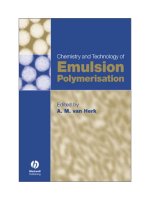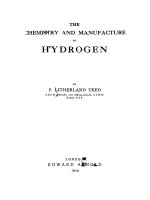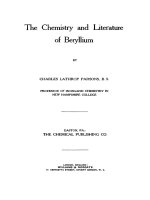291857948 ionescu mihail chemistry and technology of polyol
Bạn đang xem bản rút gọn của tài liệu. Xem và tải ngay bản đầy đủ của tài liệu tại đây (4.22 MB, 606 trang )
Chemistry and
Technology
of Polyols for
Polyurethanes
Mihail Ionescu
Chemistry and Technology of
Polyols for Polyurethanes
Mihail Ionescu
Rapra Technology Limited
Shawbury, Shrewsbury, Shropshire, SY4 4NR, United Kingdom
Telephone: +44 (0)1939 250383 Fax: +44 (0)1939 251118
First Published in 2005 by
Rapra Technology Limited
Shawbury, Shrewsbury, Shropshire, SY4 4NR, UK
©2005, Rapra Technology Limited
All rights reserved. Except as permitted under current legislation no part
of this publication may be photocopied, reproduced or distributed in any
form or by any means or stored in a database or retrieval system, without
the prior permission from the copyright holder.
A catalogue record for this book is available from the British Library.
Every effort has been made to contact copyright holders of any material reproduced within
the text and the authors and publishers apologise if any have been overlooked.
ISBN: 1-85957-491-2
Typeset, printed and bound by Rapra Technology Limited
Cover printed by Livesey Limited, Shropshire, UK
This book is dedicated to the memory of Dr Jack Buist, an exceptional personality in the
field of polyurethane chemistry and technology. His vision on the advanced technologies in
the polyurethane industry, his brilliant scientific activity leading to unanimous worldwide
recognition, the exceptional career at ICI Polyurethanes, his work as founding editor of
the international journal, Cellular Polymers and Progress has had great impact on the
general worldwide development of polyurethane chemistry and polyurethane technology
in the last five decades of the twentieth century. Dr Jack Buist will be forever, one of
polyurethane's great men and has truly earned his place alongside Professor Otto Bayer,
Professor Kurt C Frisch, Dr Adnan AR Sayigh, Dr Carlo Fiorentini and Dr Guenter Oertel
in the Polyurethane's Hall of Fame.
Chemistry and Technology of Polyols for Polyurethanes
Contents
Contents
1
Polyols ............................................................................................................ 1
1.1
Introduction ........................................................................................... 1
References ....................................................................................................... 9
2
Basic Chemistry of Polyurethanes ................................................................. 13
2.1
Reaction of Isocyanates with Alcohols ................................................. 13
2.2
Reaction of Isocyanates with Water ...................................................... 14
2.3
Reaction of Isocyanates with Urethanes ............................................... 15
2.4
Reaction of Isocyanates with Urea Groups ........................................... 15
2.5
Reaction of Isocyanates with Carboxylic Acids .................................... 15
2.6
Dimerisation of Isocyanates.................................................................. 16
2.7
Trimerisation of Isocyanates ................................................................. 17
2.8
Reaction of Isocyanates with Epoxide Compounds .............................. 17
2.9
Reaction of Isocyanates with Cyclic Anhydrides................................... 17
2.10 Prepolymer Technique .......................................................................... 23
2.11 Quasiprepolymer Technique ................................................................. 24
2.12 One Shot Technique ............................................................................. 24
2.13 Several Considerations on the Polyaddition Reaction .......................... 25
References ..................................................................................................... 27
3
The General Characteristics of Oligo-Polyols ............................................... 31
3.1
Hydroxyl Number ................................................................................ 32
3.1.1
3.2
Hydroxyl Percentage ................................................................ 34
Functionality ........................................................................................ 34
v
Chemistry and Technology of Polyols for Polyurethanes
3.3
Molecular Weight and Molecular Weight Distribution ......................... 39
3.4
Equivalent Weight ................................................................................ 40
3.5
Water Content ...................................................................................... 41
3.6
Primary Hydroxyl Content ................................................................... 41
3.7
Reactivity ............................................................................................. 45
3.8
Specific Gravity .................................................................................... 47
3.9
Viscosity ............................................................................................... 47
3.10 Colour ................................................................................................. 48
3.11 Acid Number........................................................................................ 48
References .................................................................................................... 50
4
Oligo-Polyols for Elastic Polyurethanes ........................................................ 55
4.1. Polyalkylene Oxide Polyether Polyols .................................................. 55
4.1.1
Synthesis of Polyether Triols Based on Glycerol
Homopolymers of PO .............................................................. 64
4.1.2
Kinetics of PO Addition to Glycerol ......................................... 75
4.1.3
Random Copolyethers PO-EO (Heteropolyether Polyols) ........ 93
4.1.4
Polyether Polyols Block Copolymers PO-EO .......................... 101
4.1.5
Technology for Polyether Polyol Fabrication ......................... 119
4.2
Anionic Polymerisation of Alkylene Oxides Catalysed
by Phosphazenium Compounds ......................................................... 148
4.3
High Molecular Weight Polyether Polyols Based on
Polyamine Starters. Autocatalytic Polyether Polyols ........................... 152
References ................................................................................................... 155
5
Synthesis of High Molecular Weight Polyether Polyols with Double
Metal Cyanide Catalysts (DMC Catalysts) ................................................. 167
References ................................................................................................... 178
6
vi
Polymer Polyols (Filled Polyols) .................................................................. 185
Contents
6.1
Graft Polyether Polyols....................................................................... 186
6.2
The Chemistry of the Graft Polyether Polyols Synthesis ..................... 187
6.3
6.2.1
Generation in situ of NAD by Grafting Reactions .................. 193
6.2.2
Stabilisation of Polymer Dispersions in Polymer
Polyols with Macromers (Reactive NAD) .............................. 197
6.2.3
Nonreactive Nonaqueous Dispersants .................................... 204
6.2.4
The Mechanism of Polymer Particle Formation in
Polymer Polyols Synthesis by Radical Polymerisation ............. 207
The Technology of Polymer Polyols Manufacture by
Radical Processes................................................................................ 209
6.3.1
Synthesis of Polymer Polyols by Using Preformed
Aqueous Polymeric Lattices .................................................... 214
6.4
PHD Polymer Polyols (Polyurea Dispersions) ..................................... 215
6.5
Polyisocyanate Polyaddition (PIPA) Polymer Polyols .......................... 219
6.6
Other Polymer Polyols........................................................................ 223
6.6.1
Epoxy Dispersions .................................................................. 223
6.6.2
Polyamide Dispersions............................................................ 225
6.6.3
Aminoplast Dispersions .......................................................... 226
References ................................................................................................... 227
7
Polyether Polyols by Cationic Polymerisation Processes .............................. 235
7.1
Polytetrahydrofuran (Polytetramethylene Glycols) ............................ 235
7.2
High Molecular Weight Polyalkylene Oxide Polyols
by Cationic Polymerisation................................................................. 245
7.3
Polyether Diols and Triols, Copolymers THF-alkylene Oxides ........... 249
References ................................................................................................... 257
8
Polyester Polyols for Elastic Polyurethanes ................................................. 263
8.1
Chemistry of Polyester Polyol Synthesis.............................................. 264
8.2
Consideration of the Kinetics of Polyesterification Reactions ............. 270
vii
Chemistry and Technology of Polyols for Polyurethanes
8.2.1
Self Catalysed Polyesterification Reactions
(Without Catalyst).................................................................. 270
8.2.2
Side Reactions in Polyesterification ........................................ 274
8.2.3
Hydrolysis Resistant Polyester Polyols ................................... 276
8.3
Technology for Polyester Polyols Fabrication ..................................... 277
8.4
Poly (¡-caprolactone) Polyols.............................................................. 279
8.5
Polycarbonate Polyols ........................................................................ 285
References ................................................................................................... 289
9
Polybutadiene Polyols ................................................................................. 295
9.1
Polybutadiene Polyols by Radical Polymerisation of Butadiene .......... 295
9.2
Synthesis of Polybutadiene Polyols by Radical
Polymerisation of Butadiene ............................................................... 299
9.3
Synthesis of Polybutadiene Polyols by Anionic
Polymerisation of Butadiene ............................................................... 301
References .................................................................................................. 303
10 Acrylic Polyols ............................................................................................ 305
References ................................................................................................... 309
11 Polysiloxane Polyols ................................................................................... 311
References ................................................................................................... 315
12 Polyols for Rigid Polyurethanes - General Considerations .......................... 317
References ................................................................................................... 319
13 Polyether Polyols for Rigid Polyurethane Foams ......................................... 321
13.1 The Polyaddition of Alkylene Oxides to Hydroxyl Groups ................ 325
13.1.1 The Mechanism of Alkylene Oxide Polyaddition to
Hydroxyl Groups Catalysed by the Tertiary Amines .............. 326
13.2 Polyether Polyols Technologies for Rigid Foam Fabrication ............... 336
viii
Contents
13.2.1 Anionic Polymerisation of PO (or/and EO) Initiated
by Polyols which are Liquid at the Reaction Temperature ...... 343
13.3 Kinetic Considerations Concerning the Alkoxylation of
Polyols to Rigid Polyether Polyols ...................................................... 347
13.3.1 Anionic Polymerisation of PO (or/and EO) Initiated
by High Melting Point Polyols which are Solid at the
Reaction Temperature ............................................................ 353
References ................................................................................................... 366
14 Aminic Polyols ............................................................................................ 371
References ................................................................................................... 379
15 Rigid Polyols Based on the Alkoxylation of Aromatic Compounds
Condensates with Aldehydes ...................................................................... 381
15.1 Mannich Polyols................................................................................. 381
15.2 Novolak-Based Polyether Polyols ....................................................... 400
15.3 Bisphenol A Based Polyols .................................................................. 403
15.4 Resorcinol Based Diols ....................................................................... 406
15.4 Melamine-Based Polyols for Rigid Polyurethanes ............................... 407
References ................................................................................................... 414
16 Polyester Polyols for Rigid Polyurethane Foams ......................................... 419
16.1 Aromatic Polyester Polyols from Bottom Residues
Resulting in DMT Fabrication............................................................ 421
16.2 Aromatic Polyester Polyols from Polyethylene
Terephthalate Wastes (Bottles, Films, Fibres) ...................................... 422
16.3 Aromatic Polyester Polyols Based on Phthalic Anhydride (PA) ........... 424
16.4 Other Methods for the Synthesis of Polyester Polyols for
Rigid Foams ...................................................................................... 426
References ................................................................................................... 431
ix
Chemistry and Technology of Polyols for Polyurethanes
17 Polyols from Renewable Resources - Oleochemical Polyols ........................ 435
17.1 Vegetable Oil Polyols (Oleochemical Polyols) .................................... 443
17.1.1 Synthesis of Vegetable Oil Polyols by using
Reactions Involving Ester Groups........................................... 450
17.1.2 Synthesis of Vegetable Oil Polyols by using
Reactions Involving the Double Bonds ................................... 455
17.1.3 Other Reactions Involving Reactions of
Double Bonds of Vegetable Oils ............................................. 463
17.1.4 Other Renewable Materials .................................................... 469
References .................................................................................................. 470
18 Flame Retardant Polyols ............................................................................. 477
18.1 Chlorine and Bromine Containing Polyols.......................................... 481
18.2 Phosphorus Polyols ............................................................................ 485
18.2.1 Esters of Ortho-Phosphoric Acid ............................................ 485
18.2.2 Esters of Phosphorus Acid ...................................................... 486
18.2.3 Phosphonate Polyols .............................................................. 487
18.2.4 Phosphine Oxide Polyols ........................................................ 493
18.2.5 Phosphoramidic Polyols ......................................................... 494
References ................................................................................................... 496
19 New Polyol Structures for Rigid Polyurethane Foams ................................. 501
19.1 Amidic Polyols ................................................................................... 501
19.2 Hyperbranched Polyols and Dendritic Polyols .................................... 505
References .................................................................................................. 513
20 Oligo-Polyols by Chemical Recovery of PU Wastes .................................... 515
20.1 Hydrolysis of PU Polymers ................................................................. 516
20.2 Glycolysis of PU Polymers .................................................................. 517
20.3 Aminolysis of PU Polymer .................................................................. 518
x
Contents
20.4 Alkoxylation of PU Polymer ............................................................... 520
20.5 Chemical Recovery of Flexible PU Foam Wastes by Hydrolysis .......... 522
20.6 Rigid Polyols by Glycolysis of Rigid PU Foam Wastes ........................ 523
20.7 Rigid Polyols by Aminolysis of Rigid PU Foam Wastes ...................... 525
20.8 Technology for Chemical Recovery of Rigid PU Foams
(and Isocyanuric Foams) by the Glycolysis Processes .......................... 528
References .................................................................................................. 531
21 Relationships Between the Oligo-Polyol Structure and
Polyurethane Properties .............................................................................. 535
21.1 Molecular Weight ............................................................................... 535
21.1.1 The Effect of the Molecular Weight of Oligo-Polyols ............. 536
21.2 Intermolecular Forces ......................................................................... 538
21.2.1 The Effect of the Chemical Nature of Oligo-Polyol Chains .... 538
21.3 Stiffness of the Chain.......................................................................... 540
21.4 Crystallinity........................................................................................ 542
21.5 Crosslinking ....................................................................................... 542
21.5.1 The Effect of Oligo-Polyol Functionality ................................ 542
21.5.2 The Effect of Oligo-Polyol Structure on the
Polyurethane Behaviour in Contact with Organic
Solvents and Water ................................................................. 546
21.6 Thermal Stability and Flame Retardancy ............................................ 547
21.6.1 Flame Retardancy................................................................... 548
Postface ............................................................................................................. 551
Abbreviations .................................................................................................... 553
Index ................................................................................................................. 557
xi
Chemistry and Technology of Polyols for Polyurethanes
xii
Preface
Preface
The first polyurethane synthesised by Dr Otto Bayer, in 1937, at IG Farbenindustrie
(Germany), by the reaction of a polyester diol with a diisocyanate, opened a new way
in macromolecular chemistry: that is the synthesis of polymers by a new reaction, called
polyaddition reaction.
Polyurethanes, having a relatively short history, of slightly more than 65 years, became
one of the most dynamic groups of polymers, and their use covers practically all the fields
of polymer applications - foams, elastomers, thermoplastics, thermorigids, adhesives,
coatings, sealants, fibres and so on. Polyurethanes are used in nearly every aspect of
daily life, changing the quality of human life. Furniture, bedding, seating for cars, shoe
soles, thermoinsulation for refrigerators and buildings, wood substitutes, packaging, and
coatings, are only a few common examples of polyurethane use in every day life.
Polyurethanes are obtained by the reaction of an oligomeric polyol (low molecular weight
polymer with terminal hydroxyl groups) and a diisocyanate (or polyisocyanate). The
structure of the oligomeric polyol used for polyurethane manufacture has a very profound
effect on the properties of the resulting polymer.
The present monograph is dedicated to these very important raw materials used to build the
polyurethane polymeric architecture: and covers chemistry and technology of oligomeric
polyol fabrication, properties of these hydroxyl terminated oligomers and the effects of
the oligomeric polyol structure on the resulting polyurethane properties.
So as not to be confused over the term ‘polyol’ some explanations are necessary. Generally,
the term ‘polyol’ is used, in organic chemistry, for low molecular weight organic substances,
very clearly identified as molecular entities, having more than two hydroxyl groups, such
as: glycerol, propylene glycol, sorbitol and so on. The term ‘polyol’, is frequently used
in relation to polyurethane fabrication, for all polyhydroxylic intermediates used. To be
very clear, the present monograph is a study exclusively focused on oligomeric polyols,
particularly low molecular weight polymers with terminal hydroxyl groups, covered by
the general term of ‘oligo-polyols’. These oligo-polyols are not unique molecular species,
xiii
Chemistry and Technology of Polyols for Polyurethanes
being similar to all the polymers: a mixture between homologue species with various
molecular weights (they have a molecular weight distribution). These oligo-polyols have
an average molecular weight, by contrast with the low molecular weight of the polyols
from organic chemistry which have a clear and unique molecular weight. In the text
of this monograph, if the chemical nature of oligo-polyol is known, before the name
‘polyol’ is used the chemical name of the oligomeric chain, such as: polyether polyols,
polyester polyols, polycarbonate polyols, acrylic polyols, Mannich polyols and so on. If
the oligomeric polyols, are discussed generally, the term used will be ‘oligo-polyol’.
Many excellent monographs have been dedicated to polyurethanes and, of course, the
oligo-polyols were described there, but in a very general manner. The present monograph
goes into the details of oligo-polyols synthesis in depth, and explains the chemical and
physico-chemical subtleties of all oligo-polyol fabrications.
A large variety of chemical reactions for the synthesis of oligo-polyols to build the chemical
architecture of oligo-polyols are used, such as: ring opening polymerisation of cyclic
monomers by anionic, cationic or coordinative mechanisms, polycondensation reactions
(polyesterification, transesterification, Mannich reactions, phenol-aldehydes condensations
and so on), alkoxylation, radical polymerisation, transformation of double bonds in
hydroxyl groups, such as: epoxydation-hydrolysis, hydroxylation, hydroformylation,
ozonolysis-reduction and so on), oxidation and amidation reactions. These varieties of
chemical reactions need serious knowledge of organic and macromolecular chemistry
and the author tries to explain, in a very simple and accessible manner, the very complex
phenomena involved in oligo-polyol fabrication.
The scientific literature dedicated to oligo-polyols is really impressive and the majority of
information is based on the patent literature. The scientific literature, dedicated exclusively
to oligo-polyols for polyurethanes is unexpectedly scarce. As an immediate consequence,
the present monograph is based especially on the patent literature and on the personal
experience of the author, who has worked for more than 30 years, on the synthesis of
oligo-polyols for polyurethanes. As mentioned before, there are excellent books dedicated
to polyurethanes and an excellent book dedicated to the chemistry and technology of
isocyanates. The present monograph, dedicated to the second very important component
of polyurethane fabrication, oligo-polyols, tries to complete this series of monographs in
a logical manner.
This book attempts to link in a general concept, organised in a systematic manner, the most
important knowledge, data and information concerning the chemistry and technology of
oligo-polyols for polyurethanes. This general point of view resulting from the fact that
all oligo-polyols used for polyurethanes have many things in common, will be presented,
in detail, in this monograph. In order not to provide too much information, and to
avoid presentation of confidential data, the commercial names of the oligo-polyols are
xiv
Preface
not mentioned. Thus, each oligo-polyol is identified by the chemical structure or by the
chemical name. At the same time and for the same reasons, the names of companies which
developed and produced the various types of common oligo-polyols are not mentioned.
The commercial name and the company name is specified exceptionally, only for the
unanimously accepted very important developments in the area of oligo-polyols (e.g.,
PHD-polyols of BAYER and so on).
Of course, it is totally impossible to cover all the aspects and to describe all the oligopolyol structures created as a consequence of the impressive worldwide creative effort of
research laboratories from companies, universities, research centers and institutes, but I
am sure that the most important aspects of oligo-polyol manufacture are presented.
The present monograph is addressed to all specialists working in the area of oligo-polyols
for polyurethanes: students, researchers, scientists, engineers, professors, experts from:
industry, universities, research centers and research institutes.
I hope that the monograph will be the start for new and original and developments in the
area of oligo-polyols for polyurethanes, including creation of totally new oligo-polyols,
with a new design and new chemical architecture, and of course for new technologies and
unconventional manufacturing technologies.
Good luck!
I express my profound gratitude to my wife Adriana for her continuous and unconditional
help and support.
I am grateful to, and I thank very much Ms Frances Powers, Senior Commissioning
Editor, Rapra Technology, for her tenacity, patience, attention, high competency and
professionalism to review and correct each page, each table, each formula, each sentence,
each reference, each word, each sign and to produce the book to such standard. I am also
grateful to Frances, for the fact that all the time she believed in me, and in my capability
to finish the book.
I would also like thank very much to the following members of Rapra’s Publishing
Department: Ms Claire Griffiths and Mrs Hilary Moorcroft (editorial assistants) and
Mrs Sandra Hall for typesetting the book and designing the cover, all of whom have done
a remarkable job, in producing such a high quality book.
Mihail Inonescu
August 2005
xv
Chemistry and Technology of Polyols for Polyurethanes
xvi
Polyols
1
Polyols
Author
1.1 Introduction
The polyurethanes are a special group of heterochain polymers, characterised by the
following structural unit [1-33]:
The urethane groups -NH-COO- are esters of carbamic acid, an hypothetically unstable
(and impossible to obtain under normal conditions) acid [R-NH-COOH]. It is possible
to synthesise the urethane groups by various methods [22], but the most important one
is the reaction between an isocyanate and an alcohol [1-33]:
isocyanate
alcohol
urethane
The first urethane was synthesised, by this route, as early as 1849 by Wurtz [6, 16, 22, 30].
In 1937, following very systematic and intensive research works at IG Farbenindustrie,
in Germany, Dr. Otto Bayer synthesised the first polyurethane, by the reaction of a
diisocyanate with a polyester having two terminal hydroxyl groups (called polyester diol,
in fact an _,t
In fact, Bayer invented a new method for the synthesis of macromolecular compounds:
the polyaddition reaction, which is a special case of polycondensation, with the difference
that the reaction product is exclusively the polymer. In the classical polycondensation
reactions, the products are: the polycondensation polymer and a low molecular weight
(MW) compound (water, alcohols, and so on). The fact that in the polyaddition reactions
1
Chemistry and Technology of Polyols for Polyurethanes
the product is only the polymer is of great technological importance, especially for the
purity and the morphology of the resulting macromolecular compound.
In the slightly more than 65 years of the existence of polyurethanes, the growth of the
polyurethanes was constant and the prediction for the future is very optimistic due to the
new markets opened in Eastern Europe, Asia and South America [34].
In Figure 1.1, one can see the growth of polyurethane consumption, between 20002004.
Figure 1.2 shows the world consumption of polyether polyols and polyester polyols for
polyurethanes in the period of time 2000-2004.
Polyurethanes represent only 5% of the worldwide polymer consumption (Figure 1.3
shows around 10.6 million metric tonnes in 2004), but the dynamics of their growth is
constantly high, around 4-6% [35].
The main field of polyurethane application is the furniture industry, around 30% of the
total polyurethanes produced worldwide is used for the production of mattresses from
flexible slabstock foams. Automotive manufacture is the second important application
for flexible and semiflexible polyurethanes (seat cushioning, bumpers, sound insulation,
and so forth). Rigid polyurethane foams are used in thermal insulation of buildings
and refrigerators, cold stores, pipe insulation, refrigerated transport, thermal insulation
in chemical and food industries. The polyurethane elastomers are used for shoe soles,
Figure 1.1 World consumption of polyurethanes (2000-2004)
2
Polyols
5,000, 000
Tonnes
4,000,000
3,000,000
Polyether
Polyester
2,000,000
1,000,000
0
2000
2002
2004
Year
Figure 1.2 World consumption of polyether and polyester polyols for polyurethanes
between 2000-2004
Figure 1.3 Polyurethanes and world production of plastics
3
Chemistry and Technology of Polyols for Polyurethanes
footwear, athletic shoes, pump and pipe linings, industrial tyres, microcellular elastomers,
etc. Polyurethane adhesives, sealants, coatings and fibres represent another group of
polyurethanes with specific applications. The main applications of polyurethanes are
presented in Figure 1.4 [35].
Figure 1.5 shows that the majority of polyurethanes used worldwide are foams (flexible,
semiflexible, rigid foams), around 72% from the total polyurethanes.
Figure 1.4 The main applications of polyurethanes
Figure 1.5 World consumption of polyurethanes, by products (2000-2002)
4
Polyols
Figure 1.6 Classification of polyurethanes as function of crosslink density and stiffness
It is well known that a foam is a composite solid-gas material. The continuous phase is
the polyurethane polymer and the discontinuous phase is the gas phase. Polyurethanes are
an extremely versatile group of polymers, produced in a wide range of densities, crosslink
densities and stiffnesses, from very soft to very hard structures, as shown in Figure 1.6.
Considering the practical and applicative reasons, the polyurethanes can be divided into two
main categories: elastic polyurethanes, e.g., flexible foams, elastomers, coatings, adhesives,
fibres etc., and rigid polyurethanes, e.g., rigid polyurethane foams, structural foams, wood
substitutes, solid polyurethanes, etc. This common classification of polyurethanes in elastic
and rigid polyurethanes is mainly based on the oligo-polyol structure. Thus, the general
reaction for the polyurethane synthesis is:
5
Chemistry and Technology of Polyols for Polyurethanes
The MW of the oligo-polyols used in polyurethane synthesis varies between 30010000 daltons, in the region of low MW polymers (oligomers), the number of hydroxyl
groups/molecule of oligo-polyol (the oligo-polyol functionality) being generally in the
range of 2-8 OH groups/mol.
A polyol of low functionality, having around 2-3 hydroxyl groups/mol and with a high
MW of 2000-10000 daltons, leads to an elastic polyurethane and on the contrary, a low
MW oligo-polyol of 300-1000 daltons, with a high functionality of around 3-8 hydroxyl
groups/mol leads to a rigid crosslinked polyurethane.
A diisocyanate reacted with a high MW diol (for example polyether or polyester diol of
MW of 2000-4000) leads to very elastic linear polyurethanes (polyurethane elastomers)
[3, 6, 13, 14, 24, 25]. The urethane linkages (and urea linkages), because of the possibility
of association by hydrogen bonds, generate the ‘hard domain‘ or ‘hard segment‘ of a
polyurethane elastomer. The high mobility of high MW polyol chains represent the ‘soft
domain’ or ‘soft segment’ and assures the high elasticity of the resulting polyurethane
elastomer (Figures 1.7 and 1.8).
This structure is in fact an interesting, virtually crosslinked structure by secondary bonds
(hydrogen bonds). At higher temperatures, the hydrogen bonds are destroyed and it is
6
Polyols
Figure 1.7 The ‘hard domains’ and ‘soft domains’ of polyurethane elastomers
Figure 1.8 ‘Virtually’ crosslinked polyurethane elastomers
7









